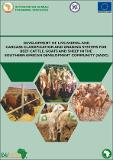| dc.contributor.author | AU-IBAR | |
| dc.contributor.author | Patrick H R Tawonezvi, (Dr) | |
| dc.date.accessioned | 2022-10-12T08:44:37Z | |
| dc.date.available | 2022-10-12T08:44:37Z | |
| dc.date.issued | 2021-05 | |
| dc.identifier.uri | http://repository.au-ibar.org/handle/123456789/1329 | |
| dc.description.abstract | This report reviews and analyses the status of live animal and carcass classification and grading systems for
beef cattle, goats and sheep within the SADC Member States, explores the opportunities and strategies
for development of improved systems, and suggests the processes of developing a regional policy and
regulations for live animal and carcass classification systems, and for domesticating and adopting the
proposed systems. | |
| dc.description.sponsorship | European union | en |
| dc.format.extent | 87 Pages | en |
| dc.language.iso | en | en |
| dc.publisher | AU-IBAR | en |
| dc.subject.classification | Live2Africa | |
| dc.title | Development of live animal and carcass classification and grading systems for beef cattle, goats and sheep in the southern African development community (SADC) | en |
| dc.type | Technical Report | en |
